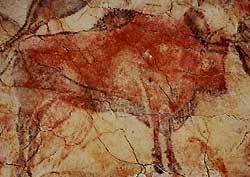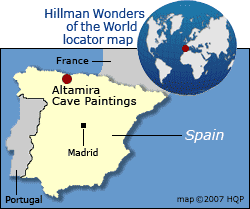Altamira Cave Paintings
 Why the
Altamira Cave Paintings
are special
Why the
Altamira Cave Paintings
are specialThe large prehistoric paintings and engravings on the ceiling of the Altamira Cave are so impressive that they have been dubbed the Sistine Chapel of the Stone Age.
Brief history of the Altamira Cave paintings
Early history
They were drawn sometime between 16,500 and 14,000 years ago. Then, cave life came to an abrupt halt. A landslide sealed the Altamira Cave entrance, preserving the Paleolithic artwork.
19th century
The cave was discovered in 1868 by a hunter. No one noticed the ceiling images until 1879 when a young girl spotted them. Her nobleman father formally announced their existence. Some leading experts accused him of forgery because they felt that the artwork was too skilled for Stone Age humans. He would eventually lose face.
20th century
In 1902, after the father passed away, the scholarly world realized that the illustrations were authentic.
Altamira Cave paintings tips & insights
How to pronounce
Altamira: ahl-tah' mee-rah'
What the name means
Altamira means "high view" in the Spanish language.
Measurements
Altamira Cave is 270 meters (890 feet) long. Ceilings are low.
The main chamber measures 18 by 9 meters (60 by 30 feet) in area. It contains renowned animal drawings. Those of bisons (see photo) are the most famous. There are also human hand prints and hand stencils (presumably done by the artists).
Wait list
Breathing releases CO2, which damages pigments. That's why the Altamira Cave is now closed to the public except for about two dozen lucky visitors per day. There is a 2 to 3 year wait list.
Fortunately, the site has a museum that includes a faithful, full-sized replica of the Altamira Cave. It depicts what the cavern looked like 15,000 years ago.
Location in Spain



